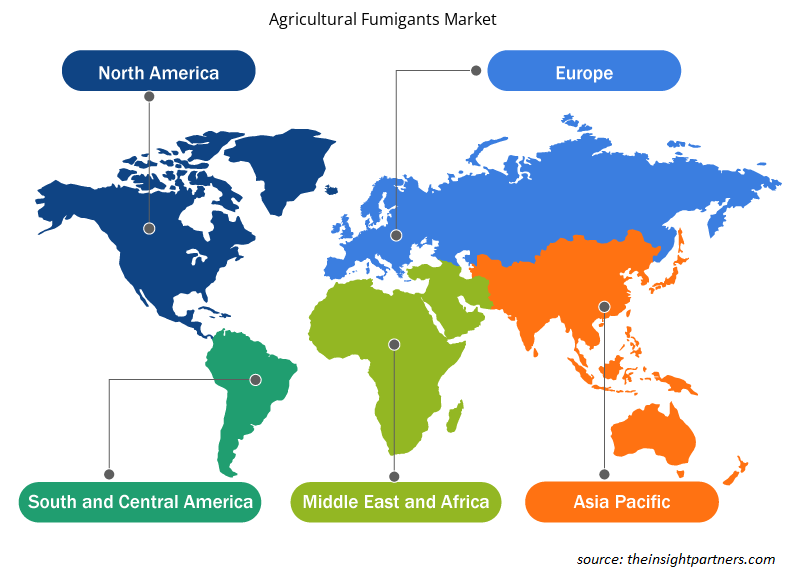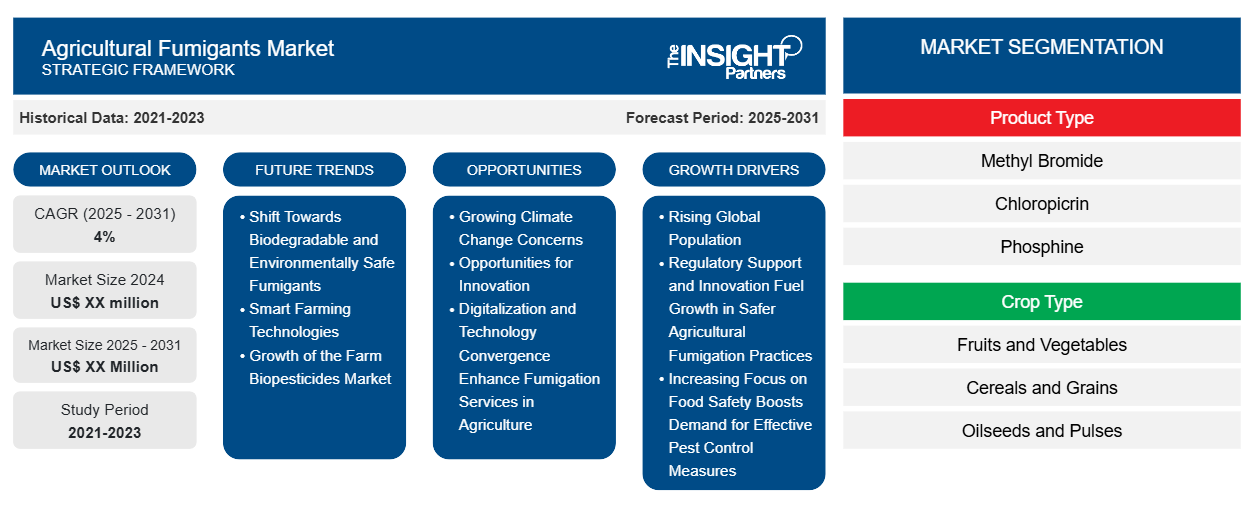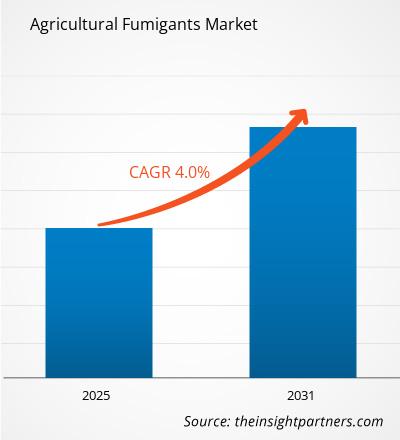Si prevede che il mercato dei fumiganti agricoli registrerà un CAGR del 4% dal 2023 al 2031, con una dimensione di mercato in espansione da XX milioni di dollari USA nel 2023 a XX milioni di dollari USA entro il 2031.
Il rapporto sul mercato dei fumiganti agricoli è segmentato per tipo di prodotto (bromuro di metile, cloropicrina, fosfina, metam sodio, 1 3-dicloropropene e altri). Il mercato è segmentato in base al tipo di coltura (frutta e verdura, cereali e granaglie, semi oleosi e legumi e altri). Il mercato è segmentato in base all'applicazione (terreno, magazzino e altri). L'analisi globale è ulteriormente suddivisa a livello regionale e nei principali paesi. Le dimensioni del mercato e le previsioni a livello globale, regionale e nazionale per tutti i segmenti di mercato chiave sono coperte nell'ambito. Il rapporto offre il valore in USD per l'analisi, i segmenti, le regioni e i paesi di cui sopra. Il rapporto copre le tendenze di mercato, nonché le dinamiche di mercato come driver, restrizioni e opportunità chiave. Il rapporto copre anche il panorama del settore e l'analisi della concorrenza che copre la concentrazione del mercato, l'analisi della mappa di calore, i principali attori e gli sviluppi recenti nel mercato.
Scopo del rapporto
Il report Agricultural Fumigants Market di The Insight Partners mira a descrivere il panorama attuale e la crescita futura, i principali fattori trainanti, le sfide e le opportunità. Ciò fornirà spunti a vari stakeholder aziendali, come:
- Fornitori/produttori di tecnologia: per comprendere le dinamiche di mercato in evoluzione e conoscere le potenziali opportunità di crescita, consentendo loro di prendere decisioni strategiche informate.
- Investitori: condurre un'analisi completa delle tendenze in merito al tasso di crescita del mercato, alle proiezioni finanziarie del mercato e alle opportunità esistenti lungo la catena del valore.
- Enti di regolamentazione: regolamentano le politiche e le attività di controllo sul mercato allo scopo di ridurre al minimo gli abusi, preservare la fiducia degli investitori e sostenere l'integrità e la stabilità del mercato.
Segmentazione del mercato dei fumiganti agricoli
Tipo di prodotto
- Bromuro di metile
- Cloropicrina
- Fosfina
- Metam Sodio
- 1 3-dicloropropene
Tipo di coltura
- Frutta e verdura
- Cereali e granaglie
- Semi oleosi e legumi
Applicazione
- Suolo
- Magazzino
Geografia
- America del Nord
- Europa
- Asia-Pacifico
- America del Sud e Centro
- Medio Oriente e Africa
Geografia
- America del Nord
- Europa
- Asia-Pacifico
- America del Sud e Centro
- Medio Oriente e Africa
Personalizza questo report in base alle tue esigenze
Riceverai la personalizzazione gratuita di qualsiasi report, comprese parti di questo report, o analisi a livello nazionale, pacchetto dati Excel, oltre a usufruire di grandi offerte e sconti per start-up e università
- Scopri le principali tendenze di mercato in questo rapporto.Questo campione GRATUITO includerà analisi di dati che spaziano dalle tendenze di mercato alle stime e alle previsioni.
Fattori trainanti della crescita del mercato dei fumiganti agricoli
- Aumento della popolazione globale: l'aumento della popolazione globale richiede una maggiore produzione agricola. Per risolvere questo problema, gli agricoltori si sono anche rivolti alle tossine che eliminano i parassiti e le malattie che altrimenti ridurrebbero la resa delle colture. L'aumento della produttività attraverso migliori tecniche di gestione dei parassiti è indiscutibilmente la ragione principale del mercato.
- Supporto normativo e innovazione alimentano la crescita di pratiche di fumigazione agricola più sicure: il controllo dei parassiti sta diventando una preoccupazione prioritaria nella strategia di sicurezza alimentare della maggior parte dei paesi. Quindi, hanno iniziato a promulgare leggi che incoraggiano l'uso di fumiganti agricoli senza pericoli. Metodi più nuovi e migliori di eseguire la fumigazione, ad esempio dispositivi che hanno effetti meno dannosi sul liquame circostante, supportano la crescita di questo mercato.
- La crescente attenzione alla sicurezza alimentare aumenta la domanda di efficaci misure di controllo dei parassiti: c'è una crescente preoccupazione per la qualità e la sicurezza dei prodotti alimentari. Di conseguenza, efficaci misure di controllo dei parassiti sono molto ricercate sul mercato. I fumiganti aiutano a mantenere i cereali e i raccolti immagazzinati liberi da parassiti, promuovendo così la sicurezza alimentare.
Tendenze future del mercato dei fumiganti agricoli
- Passaggio a fumiganti biodegradabili e sicuri per l'ambiente: il settore è sicuramente sulla buona strada per adottare pratiche sostenibili in tutte le operazioni. È molto probabile che in futuro lo sviluppo e l'uso di fumiganti saranno biodegradabili, meno tossici e sicuri per l'ambiente. Questi cambiamenti sono stati sperimentati come risultato della regolamentazione governativa sull'uso di fumiganti agricoli e della tendenza sempre crescente per i problemi ambientali derivanti dall'agricoltura da parte della società.
- Tecnologie per l'agricoltura intelligente: le tecnologie innovative di punta dell'agricoltura intelligente contribuiranno anche alla gestione della fumigazione in futuro. L'uso di analisi dei dati, GPS e IOT consentirà agli agricoltori di applicare i fumiganti in modo più efficiente, individuando con precisione le infestazioni di parassiti del bestiame. Questo modo esplosivo di gestire i parassiti produrrà un sistema di gestione integrata dei parassiti più appropriato ed economicamente ragionevole.
- Crescita del mercato dei biopesticidi agricoli: con le crescenti preoccupazioni per la salute e l'ambiente della popolazione, si stima che il mercato dei biopesticidi agricoli si espanderà. Alternative più sane ai pesticidi chimici, questi fumiganti a base di composti organici volatili sono altamente efficaci per il controllo dei parassiti, garantendo al contempo minori rischi per l'ambiente e la salute, il che suggerisce una probabile ristrutturazione nei sistemi del mercato dei fumiganti.
Opportunità di mercato per i fumiganti agricoli
- Crescenti preoccupazioni per il cambiamento climatico: le economie avanzate, specialmente in continenti particolari come Asia e Africa, offrono immense possibilità. Con le crescenti preoccupazioni per il cambiamento climatico, mentre queste regioni sviluppano i loro metodi agricoli e metodi per controllare i parassiti, ci sarà un'elevata necessità di fumiganti efficienti che rappresentano una buona opportunità di business per i produttori.
- Opportunità di innovazione: esiste un grande potenziale di miglioramento nella formulazione e nell'uso dei fumiganti. Ci sono anche vantaggi da ottenere investendo nello sviluppo di nuovi prodotti fumiganti sicuri ed efficaci, in quanto creerà un vantaggio rispetto ai concorrenti. Gli sforzi congiunti di questi possono portare a nuovi sviluppi nelle tecnologie dei fumiganti.
- La digitalizzazione e la convergenza tecnologica migliorano i servizi di fumigazione in agricoltura: l'attuale processo di digitalizzazione del business circolare agricolo offre una buona opportunità per incorporare i servizi di fumigazione in una piattaforma digitale. Le aziende possono ora utilizzare dati e applicazioni mobili per migliorare l'efficienza e l'efficacia dei servizi di fumigazione in modo personalizzato. Questo è definito convergenza tecnologica, in cui vengono create nuove attività e i clienti vengono integrati in modo migliore.
Approfondimenti regionali sul mercato dei fumiganti agricoli
Le tendenze regionali e i fattori che influenzano il mercato dei fumiganti agricoli durante il periodo di previsione sono stati ampiamente spiegati dagli analisti di Insight Partners. Questa sezione discute anche i segmenti e la geografia del mercato dei fumiganti agricoli in Nord America, Europa, Asia Pacifico, Medio Oriente e Africa e America meridionale e centrale.

- Ottieni i dati specifici regionali per il mercato dei fumiganti agricoli
Ambito del rapporto sul mercato dei fumiganti agricoli
| Attributo del report | Dettagli |
|---|---|
| Dimensioni del mercato nel 2023 | XX milioni di dollari USA |
| Dimensioni del mercato entro il 2031 | XX milioni di dollari USA |
| CAGR globale (2023-2031) | 4% |
| Dati storici | 2021-2022 |
| Periodo di previsione | 2024-2031 |
| Segmenti coperti | Per tipo di prodotto
|
| Regioni e Paesi coperti | America del Nord
|
| Leader di mercato e profili aziendali chiave |
|
Densità degli operatori del mercato dei fumiganti agricoli: comprendere il suo impatto sulle dinamiche aziendali
Il mercato dei fumiganti agricoli sta crescendo rapidamente, spinto dalla crescente domanda degli utenti finali dovuta a fattori quali l'evoluzione delle preferenze dei consumatori, i progressi tecnologici e una maggiore consapevolezza dei benefici del prodotto. Con l'aumento della domanda, le aziende stanno ampliando le loro offerte, innovando per soddisfare le esigenze dei consumatori e capitalizzando sulle tendenze emergenti, il che alimenta ulteriormente la crescita del mercato.
La densità degli operatori di mercato si riferisce alla distribuzione di aziende o società che operano in un particolare mercato o settore. Indica quanti concorrenti (operatori di mercato) sono presenti in un dato spazio di mercato in relazione alle sue dimensioni o al valore di mercato totale.
Le principali aziende che operano nel mercato dei fumiganti agricoli sono:
- Società anonima ADAMA Ltd.
- Società chimica AMVAC
- Gruppo Arkema
- BASF SE
- Isagro SpA
Disclaimer : le aziende elencate sopra non sono classificate secondo un ordine particolare.

- Ottieni una panoramica dei principali attori del mercato dei fumiganti agricoli
Punti di forza chiave
- Copertura completa: il rapporto copre in modo completo l'analisi di prodotti, servizi, tipologie e utenti finali del mercato dei fumiganti agricoli, fornendo una panoramica olistica.
- Analisi degli esperti: il rapporto è compilato sulla base della conoscenza approfondita di esperti e analisti del settore.
- Informazioni aggiornate: il rapporto garantisce la pertinenza aziendale grazie alla copertura di informazioni recenti e tendenze nei dati.
- Opzioni di personalizzazione: questo report può essere personalizzato per soddisfare le esigenze specifiche del cliente e adattarsi in modo appropriato alle strategie aziendali.
Il rapporto di ricerca sul mercato dei fumiganti agricoli può, quindi, aiutare a guidare il percorso di decodificazione e comprensione dello scenario del settore e delle prospettive di crescita. Sebbene possano esserci alcune preoccupazioni valide, i vantaggi complessivi di questo rapporto tendono a superare gli svantaggi.
- Analisi storica (2 anni), anno base, previsione (7 anni) con CAGR
- Analisi PEST e SWOT
- Valore/volume delle dimensioni del mercato - Globale, regionale, nazionale
- Industria e panorama competitivo
- Set di dati Excel



Report Coverage
Revenue forecast, Company Analysis, Industry landscape, Growth factors, and Trends

Segment Covered
This text is related
to segments covered.

Regional Scope
North America, Europe, Asia Pacific, Middle East & Africa, South & Central America

Country Scope
This text is related
to country scope.
Domande frequenti
Sustainability and eco-friendly solutions is expected to be the key market trends.
Based on geography, Asia Pacific held the largest share of the agricultural fumigants market due to its rapidly growing agriculture industry, rising population, the growing agricultural production.
Based on crop type, the fruits and vegetables segment is expected to witness the fastest growth during the forecast period.
AMVAC Chemical Corporation, Arkema Group, Solvay, DEGESCH America Inc., LANXESS, Nippon Chemical Industrial CO LTD, ISAGRO, Syngenta, TriCal Group Inc., and UPL are the key players operating in the agricultural fumigants market.
The growth in agricultural production is driving the market growth.
The Agricultural Fumigants Market is estimated to witness a CAGR of 4% from 2023 to 2031
Trends and growth analysis reports related to Chemicals and Materials : READ MORE..
1. ADAMA Ltd.
2. AMVAC Chemical Corporation
3. Arkema Group
4. BASF SE
5. Isagro SpA
6. LANXESS AG
7. Nippon Chemical Industrial Co., Ltd.
8. Solvay SA
9. Syngenta AG
10. UPL
The Insight Partners performs research in 4 major stages: Data Collection & Secondary Research, Primary Research, Data Analysis and Data Triangulation & Final Review.
- Data Collection and Secondary Research:
As a market research and consulting firm operating from a decade, we have published and advised several client across the globe. First step for any study will start with an assessment of currently available data and insights from existing reports. Further, historical and current market information is collected from Investor Presentations, Annual Reports, SEC Filings, etc., and other information related to company’s performance and market positioning are gathered from Paid Databases (Factiva, Hoovers, and Reuters) and various other publications available in public domain.
Several associations trade associates, technical forums, institutes, societies and organization are accessed to gain technical as well as market related insights through their publications such as research papers, blogs and press releases related to the studies are referred to get cues about the market. Further, white papers, journals, magazines, and other news articles published in last 3 years are scrutinized and analyzed to understand the current market trends.
- Primary Research:
The primarily interview analysis comprise of data obtained from industry participants interview and answers to survey questions gathered by in-house primary team.
For primary research, interviews are conducted with industry experts/CEOs/Marketing Managers/VPs/Subject Matter Experts from both demand and supply side to get a 360-degree view of the market. The primary team conducts several interviews based on the complexity of the markets to understand the various market trends and dynamics which makes research more credible and precise.
A typical research interview fulfils the following functions:
- Provides first-hand information on the market size, market trends, growth trends, competitive landscape, and outlook
- Validates and strengthens in-house secondary research findings
- Develops the analysis team’s expertise and market understanding
Primary research involves email interactions and telephone interviews for each market, category, segment, and sub-segment across geographies. The participants who typically take part in such a process include, but are not limited to:
- Industry participants: VPs, business development managers, market intelligence managers and national sales managers
- Outside experts: Valuation experts, research analysts and key opinion leaders specializing in the electronics and semiconductor industry.
Below is the breakup of our primary respondents by company, designation, and region:

Once we receive the confirmation from primary research sources or primary respondents, we finalize the base year market estimation and forecast the data as per the macroeconomic and microeconomic factors assessed during data collection.
- Data Analysis:
Once data is validated through both secondary as well as primary respondents, we finalize the market estimations by hypothesis formulation and factor analysis at regional and country level.
- Macro-Economic Factor Analysis:
We analyse macroeconomic indicators such the gross domestic product (GDP), increase in the demand for goods and services across industries, technological advancement, regional economic growth, governmental policies, the influence of COVID-19, PEST analysis, and other aspects. This analysis aids in setting benchmarks for various nations/regions and approximating market splits. Additionally, the general trend of the aforementioned components aid in determining the market's development possibilities.
- Country Level Data:
Various factors that are especially aligned to the country are taken into account to determine the market size for a certain area and country, including the presence of vendors, such as headquarters and offices, the country's GDP, demand patterns, and industry growth. To comprehend the market dynamics for the nation, a number of growth variables, inhibitors, application areas, and current market trends are researched. The aforementioned elements aid in determining the country's overall market's growth potential.
- Company Profile:
The “Table of Contents” is formulated by listing and analyzing more than 25 - 30 companies operating in the market ecosystem across geographies. However, we profile only 10 companies as a standard practice in our syndicate reports. These 10 companies comprise leading, emerging, and regional players. Nonetheless, our analysis is not restricted to the 10 listed companies, we also analyze other companies present in the market to develop a holistic view and understand the prevailing trends. The “Company Profiles” section in the report covers key facts, business description, products & services, financial information, SWOT analysis, and key developments. The financial information presented is extracted from the annual reports and official documents of the publicly listed companies. Upon collecting the information for the sections of respective companies, we verify them via various primary sources and then compile the data in respective company profiles. The company level information helps us in deriving the base number as well as in forecasting the market size.
- Developing Base Number:
Aggregation of sales statistics (2020-2022) and macro-economic factor, and other secondary and primary research insights are utilized to arrive at base number and related market shares for 2022. The data gaps are identified in this step and relevant market data is analyzed, collected from paid primary interviews or databases. On finalizing the base year market size, forecasts are developed on the basis of macro-economic, industry and market growth factors and company level analysis.
- Data Triangulation and Final Review:
The market findings and base year market size calculations are validated from supply as well as demand side. Demand side validations are based on macro-economic factor analysis and benchmarks for respective regions and countries. In case of supply side validations, revenues of major companies are estimated (in case not available) based on industry benchmark, approximate number of employees, product portfolio, and primary interviews revenues are gathered. Further revenue from target product/service segment is assessed to avoid overshooting of market statistics. In case of heavy deviations between supply and demand side values, all thes steps are repeated to achieve synchronization.
We follow an iterative model, wherein we share our research findings with Subject Matter Experts (SME’s) and Key Opinion Leaders (KOLs) until consensus view of the market is not formulated – this model negates any drastic deviation in the opinions of experts. Only validated and universally acceptable research findings are quoted in our reports.
We have important check points that we use to validate our research findings – which we call – data triangulation, where we validate the information, we generate from secondary sources with primary interviews and then we re-validate with our internal data bases and Subject matter experts. This comprehensive model enables us to deliver high quality, reliable data in shortest possible time.


 Ottieni un campione gratuito per questo repot
Ottieni un campione gratuito per questo repot